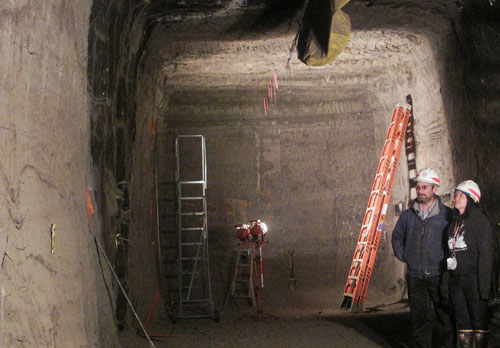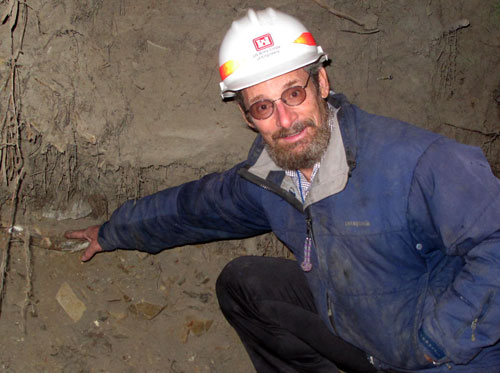
Standing in the middle of the Ice Age
July 25, 2012
“We’re standing in the middle of the ice age,” Sturm, an expert on snow, ice and other frozen things said from inside the famous Permafrost Tunnel, bored into a hillside north of Fairbanks. “This was the savanna of the north, with bison, saber-toothed cats, mammoths and horses. This is one of the great Pleistocene bonebeds in the world. Hundreds of boxes of bones came from Engineer and Goldstream creeks.” Sturm and Margaret Cysewski, both of the U.S. Army Cold Regions Research and Engineering Laboratory on Fort Wainwright recently gave me a private tour of the emerging new permafrost tunnel in Fox, along with a walk through the old one. Their goal is to alert people to a community meeting regarding the new and old tunnels in late July regarding how best to allow school-age kids and others a chance to step back in time just a few hundred yards from the Steese Highway.
Matthew Sturm and Margaret Cysewski inside the
Inside, the air smells bittersweet, like something half rotten. The air is 40 degrees colder than the summer day just outside the freezer door. Fine dust wafts from the floor, a reminder of the violent winds that carried the powder of glacier-ground silt from river valleys, constructing the hills around Fairbanks. The dirt froze into place here, along with bison horns, ponds, ancient tree stems and pond microbes that have danced with life when thawed on glass slides after a slumber of 30,000 years. Within a few steps, the tunnel allows a journey back to the Pleistocene, a time when New York City, Chicago, and almost all of Canada was beneath the blue ice of glaciers, while this spot was paradoxically a rich grassland teeming with animals. Like nowhere else, the tunnel shows that ground that froze during a colder time and has remained that way through the heat of at least two summers is in great supply in Alaska.
Matthew Sturm points out the horn of a steppe bison.
Jimmy and Rosalynn Carter have worn hard hats for a stroll in the Permafrost Tunnel, as have many senators and congressmen. With the start of a new tunnel a few hundred feet away from the old one, researchers are brainstorming on ways to share the experience with the public, rather than just VIPs or school groups who happen to know a scientist with a key to the gate. Sturm and Cysewski have organized a community meeting at Silver Gulch Brewery in Fox from 7 to 9 p.m. on July 24, 2012, and will invite the public to the old tunnel on August 18 and 19 from 10 a.m. to 3 p.m. To close out my private tour, Sturm and Cysewski escorted me into the new tunnel, about 200 feet southwest of the old one. Currently 100 feet long, the tunnel is taller than the old one — big enough to park a few mobile homes inside bumper-to-bumper. Dug by researchers and a contractor who piloted the John Deere excavator, the new tunnel is a few degrees colder than the old one and shares its musty, distinctive odor. About midway through, a massive clear wedge of ice spans the entire wall. The drilling operation also revealed an intriguing thaw pond with woody debris that froze there on a cold day 30,000 years ago. For a person who thinks a 100-year old prospector’s cabin is old, that number is hard to fathom. But it’s not for the scientists who are now squinting at the walls of the new tunnel, rediscovering the lost savanna of the north.
This column is provided as a public service by the Geophysical Institute, University of Alaska Fairbanks, in cooperation with the UAF research community.
E-mail your news &
photos to editor@sitnews.us
|
||

